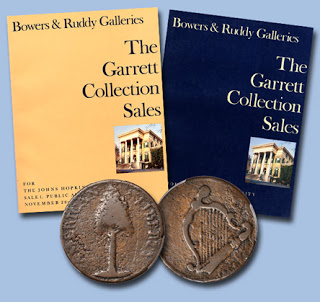
Back in 1979 and 1980, I and staffers cataloged the Garrett Collection for The Johns Hopkins University. The coins had been stored in an underground bank vault, and because of expense and security they were not available for scholarship. The University decided to sell, invited four auction houses to make presentations, and my company (Bowers and Ruddy Galleries at the time) was one of these. Bill Hawfield and I gathered ideas and went to tell of our ideas.
What the other presentations were I know not, but we were announced as the winner. At the meeting of the Board of Trustees we were told that of the four auction houses, “your commission was the highest, but our research has shown you will probably do the best job.” The coins had been appraised at about $8 million recently. I and staffers set about planning a world-class event. No expense was spared to create four superb catalogs, and I wrote a book, The History of United States Coins as Illustrated by the Garrett Collection. The first printing of 4,000 copies was sold out before the first auction took place. Demand continued and eventually about 15,000 were sold.
The sale itself realized nearly $25,000,000! Records were broken left and right and history was made.
Regarding the 1776 would you believe it realized $172,500? That is true.
If this proves anything it might dispel the popular notion that when you are seeking an auction house you should compare prices carefully. Of course, price is a consideration, but results are even more so. Ask yourself these questions:
“If I were having a house designed would I pick the cheapest architect?”
“If I were having major surgery done would I shop around for the lowest price?”
“If I desire to sell my rare coins should I go to the auction house that offers the cheapest rate?”
Some things to think about!
Best wishes,
Dave Bowers





